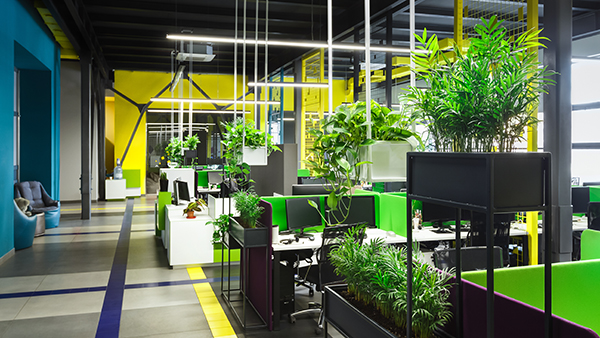
By Kristen Cifolelli, courtesy of SBAM Approved Partner ASE
Biophilia is defined as the inherent human desire to affiliate with nature. Biophilic design, an extension of biophilia, is the practice of using architecture and building design to connect people and nature. This is accomplished through incorporation of natural building materials, natural light, vegetation, and nature views into an urban environment. So how can using biophilic design in a work environment improve employee productivity?
A number of studies have shown that being closer to nature is beneficial for an individual’s health. Despite this positive benefit, according to the 2001 National Human Activity Pattern Survey, humans today spend approximately 90% of our time indoors. Another survey conducted by Ambius, an organization that supplies design and plant services for the built environment, found that 35% of office workers don’t get more than 15 minutes of outdoor time during the typical workday. 13% of individuals surveyed get 30 minutes of outdoor time, and only 26% get a full hour.
Humans have a basic biological need to connect with nature and green spaces. We have lost so much of our exposure to nature, it becomes important to find ways to bring the outdoors inside. Biophilic design is becoming a rapidly growing trend and some employers have strongly embraced this concept. Amazon has added glass domed green houses to their corporate headquarters and Microsoft has built “treehouse meeting spaces.”
Environments devoid of natural light, outside views, and nature can have a negative effect on health and well-being whereas a connection to nature can support a psychological restoration. The incorporation of biophilic design such as the use of natural elements, nature resembling colors and patterns, indoor plants and views of greenery can improve and maintain mental well-being. This will translate into a reduction of stress, enhance creativity and clarity of thought, improve productivity and energy levels, and expedite healing, particularly when employees are exposed to sunlight and outdoor views.
NBC News shared research from the Journal of Environmental Psychology that shows how the inclusion of natural scenery can enhance employee mood, morale, and productivity, including one study that found “staring at an image of natural scenery for 40 seconds was enough to trigger the brain into a more relaxed state.” In this study a control group stared at a concrete roof, while the test subjects stared at a green meadow. Beyond the feeling of relaxation, subjects who stared at the green meadow performed significantly better in a test of attention after the initial session; they made fewer mistakes and were less distracted.
Another study conducted in the UK showed a link between productivity and biophilic office design. Simply by taking a space devoid of any plants and introducing them into the work environment increased productivity by 15%. The study participants reported higher workplace satisfaction and demonstrated higher productivity.
Unfortunately for many employees, their work environment does not offer much connection to nature. 47% of employees report that they lack natural light at work and 58% have no greenery in the form of plants within their office. While many organizations would love to adopt these office design strategies to incorporate nature, often times there is the challenge of not having the luxury of a large budget to do so. Luckily, there are some low-cost options employers can adopt:
-
In many workplaces, an inspiring view outside simply isn’t possible. In these cases, it’s better to display simulated nature views such as pictures, videos, or screensavers rather than using nothing.
-
Use green as an interior office color to boost creative performance.
-
Move existing furniture and plants to create private spaces for retreating and restoring energy.
-
Create a supportive culture that encourages breaks to be taken outside.
-
Position workstations to enable views of the sky and weather outside.
Use natural soundtracks to create acoustic backdrop.
Purchase circadian lamps and lightbulbs that mimic natural light and manage natural body rhythms more effectively.
Promoting employee wellbeing is a competitive advantage for employers and bringing the outdoors into the office can be one component to creating a great work environment to retain employees and reduce absenteeism. Hopefully some of these design ideas will inspire you to implement them in your next office renovation.